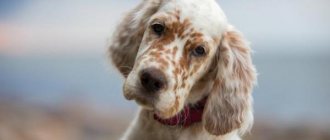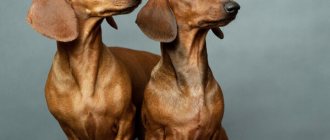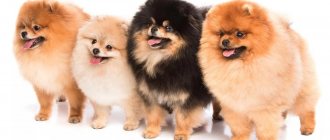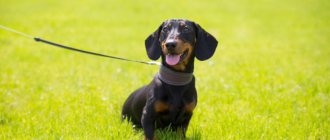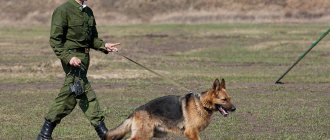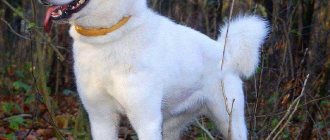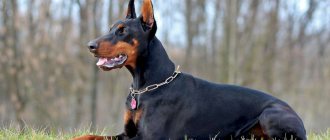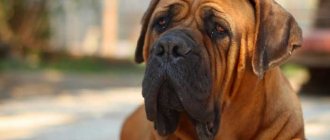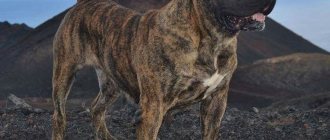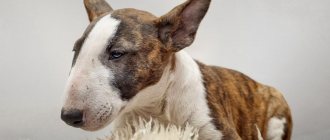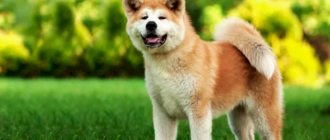Have you ever fallen in love with a handsome guy with a beard? What about the little lady with a thick bush of hair on her chin? We're talking about dogs, of course! And they don't just need these beards to look cute. It turns out that most bearded dogs were bred to hunt small game such as rodents, mice and burrowing animals. The beards protected their muzzles from animal bites, as well as from thorns, branches and anything else that a fearless dog might encounter while hunting.
Let's take a look at some of the most famous dog breeds with beards, as well as what it takes to care for those wonderful chin hairs.
Schnauzers
The beard, mustache and bangs are the “calling card” of the Schnauzer. The family includes 3 independent, outwardly similar breeds. They were bred in Germany, but each has its own selection path, character, size:
- Giant Schnauzers are large dogs with a height of 60–70 cm at the withers. Color black or pepper and salt.
- Miniature Schnauzer - medium size 45 - 50 cm. Colors like their larger counterparts.
Pepper and salt Miniature Schnauzer.
- Miniature Schnauzers are dwarf dogs 30–35 cm tall. This is the smallest service breed. In addition to the listed colors, silver-black and white are allowed.
The hard coat of Schnauzers does not shed on its own, so it is regularly plucked. Show dogs are clipped on the back and sides. A “skirt” is left along the bottom of the body and on the paws. The beard and mustache are not shortened much, but only trimmed along the edge.
Schnauzers have earned a reputation as highly trainable, non-argumentative animals with versatile abilities. They serve in the army, police, and work as personal bodyguards. They take prizes in canine sports. Schnauzer puppies grow into loyal companions and family pets.
Airedale
- Height: from 56 to 61 cm
- Weight: from 18 to 29 kg
- Life expectancy: 10 to 12 years
- Temperament: intelligent, sociable, friendly, alert, confident, courageous
The Airedale Terrier is known as the "King of Terriers" , a title earned for its tall stature, strong build and stellar reputation as hunters, wartime messenger dogs, athletes and family companions. But they are also worthy of the title “Kings of Bearded Dogs,” as few breeds can boast such magnificent mustaches and long beards—perhaps due to their majestic long noses. Whether it's dirt, water, dog food, or other debris, Airedale beards will find it, so be prepared to wash your pet's face daily, as well as wipe up any droplets he leaves behind.
Terriers with a beard
Smooth-haired representatives of the family are deprived of abundant hair on the muzzle. Bearded dogs are found among terriers with hard or semi-long soft hair. They often grow bushy eyebrows and long thick bangs that hide their eyes.
This list ranks Bearded Terriers in order of decreasing height at the withers, from largest to miniature.
Black Russian Terrier
The largest representative of the family. The height at the withers reaches 68–78 cm. The thick, coarse coat grows 5–15 cm.
Black cats were bred by Soviet military dog handlers through complex interbreeding. They inherited their beard, eyebrows, and mustaches from the Giant Schnauzers and Airedale Terriers who participated in the selection.
Airedale
In addition to the beard, the Airedale Terrier has neat eyebrows.
Originally English dogs come from the Aire Valley in Yorkshire. In Russia they became known after the release of the film “The Adventures of Electronics” with the Airedale Terrier Ressi.
Airedale Terriers are deservedly called the “kings of terriers.” They grow up to 56 – 61 cm and are second in size only to black Russian terriers. They are famous as hardy hunters, vigilant watchmen, strict guards, sensitive search engines, reasonable, balanced companions.
Irish Terrier
Jack London's favorite breed. The writer kept the “Irish” in mind and described their outstanding intelligence, endurance, and devotion in his novels.
Height at the withers is up to 48 cm. The coarse fur coat is painted red in any shade. The abilities of red bearded men are versatile and extraordinary. It is no coincidence that in early descriptions the Irish Terrier was called “the poor man’s guardian, the farmer’s friend and the master’s favorite.”
Kerry Blue Terrier
Blue Terrier from County Kerry, Ireland. The coat makes the dogs easily recognizable. The body is covered with a soft wavy fur coat, which shimmers and shines in the sun. A thick, semi-long beard hangs from the muzzle.
Kerry Blue puppies are sometimes born black or tan. But by 1.5 years the color changes to blue in all shades: from light silver to steel.
Soft Coated Wheaten Terrier
Energetic, peace-loving dogs native to Ireland. The height at the withers is up to 48 cm. The name of the breed reflects the properties and color of the fur coat. Silky, soft, shiny hair grows up to 13 cm in one layer, slightly curled. There is no undercoat, so wheaten cats do not shed. The bangs and beard are never cut too short, they are combed forward.
Wire Fox Terrier
The breed was bred in Great Britain for fox hunting, which is reflected in the name. Fox Terrier translated means fox terrier. Height at the withers is 35 – 39 cm. The coat consists of a coarse spine up to 4 cm long and a soft undercoat. The beard is hard and elongated. Color – white with red and black spots.
Welsh Terrier
The dogs come from the county of Wales. Outwardly they resemble smaller Airedale Terriers. The height of the Welsh does not exceed 39 cm. The color is sable: red with a black “cape” on the back and sides. Decorating hair frames the muzzle and grows over the eyes, forming eyebrows.
Lakeland Terrier
Another bearded man of English origin. Lakelands, like many wire-haired dogs, do not shed on their own, so trimming is necessary. Thanks to its unique structure, the wool is easy to pluck. The wire-like guard hair is softer at the roots and coarser at the ends.
Jack Russell Terrier
Miniature, agile dogs of English origin, 25–30 cm tall. The breed has 3 types of coat: smooth, hard and intermediate. A bristly beard and mustache adorn the muzzle of the rough-haired variety.
Color – white with black, brown, red spots. Jack Russells are the fastest among terriers. When running, they reach speeds of up to 61 km/h.
Scotch Terrier
A squat, short-legged dog from Scotland. Height 25 – 28 cm, colors – black, brindle, wheaten.
In addition to the decorative hair on the face, the appearance of the Scottish is impressive due to the long protruding eyebrows. Proper trimming and grooming of a show Scotch Terrier requires knowledge, experience and skill. Preparations for shows begin 3–4 months in advance.
Sealyham
Small terrier of Welsh origin. The average height at the withers is 28 cm. The color is white or with a pale lemon tint.
The breed used to be popular. In Great Britain, Sealyhams were bred to hunt burrowing animals. Then they became fashionable among Hollywood celebrities. Now interest in the breed has decreased, although owners note that their pets have an unusually caring attitude towards children.
Czech Terrier
The breed was developed by cynologist-enthusiast F. Horak based on Scottish and Sealyham terriers. The breeder managed to combine in the dogs the opposite qualities of dexterous, merciless hunters and balanced domestic companions.
Height at the withers is 27 – 29 cm. The color develops gradually. Puppies are born dark. By six months the shade changes to gray-blue or light coffee color. Unlike English Terriers, the upper part of the body can be clipped.
Yorkshire Terrier
Without a haircut, a Yorkie's beard grows all the way to the floor.
Yorkies' fur grows throughout their life and does not shed. It falls out like in humans - when scratched or damaged. Long, flowing hair grows on the head, cheeks, and chin. Close relatives of the Biro and Biewer Yorkies have similar fur coat properties.
Hunting dogs with beard
Thick, elongated hair grows on the chin in wirehaired pointers. The body is covered with short, close-lying hair. Against such a background, the beard on the muzzle is very noticeable.
Here are striking examples of bearded cops:
- Griffon Korthals. Another name is the French Wirehaired Pointer.
The dogs were named after the first breeder, the Dutchman Eduard Kortal.
- Italian spinone. Researchers of the breed claim that the Spinone has never bitten anyone.
The Italian Spinone is equally adept at hunting on water and on land.
- Drathaar. The cops come from Germany.
Drathaar means “wool like wire” in German.
- The Czech fousek is very similar in appearance to the drathaar, sometimes even dog handlers confuse them.
Czech fuosek.
When talking about bearded hunting dogs, one cannot help but remember the dachshund. The breed breeds animals with three types of coat. Smooth-haired and long-haired species are devoid of hair on the face. The wire-haired dachshund has a distinct beard and eyebrows, although the body has coarse hair that lies close to the body.
Wire-haired dachshund.
Price
Buying a dog will not be difficult. It is better, of course, to contact a specialist who will confirm the purebredness and behavior of the dog. When purchasing, relevant documents must be present that confirm the pedigree.
Border Terrier puppies
There are clubs that breed and sell puppies of this breed. The price of a border terrier for one puppy, on average, will be from 30,000 to 70,000 rubles. You can buy a puppy from your own hands. In this case, you can save a lot, but, most of all, such a puppy will be of mixed breeds and its price will be no more than 20,000 rubles.
If you buy a dog from a kennel, you will have to pay from 25,000 rubles for a furry friend. If you need a purebred border dog that meets all standards, has a beautiful color and a pure pedigree, then it will cost at least 50,000 rubles.
Herding breeds
Bearded dogs are found among long-haired shepherd dogs. The hair on the body and head grows almost the same length. Hair growth above the eyes, on the cheeks, cheekbones and chin forms a thick beard, bangs hiding the eyes, and a bushy mustache.
Catalan Shepherd
These are the first Spanish dogs to gain worldwide recognition. At home, they became skilled assistants to farmers. Catalan Shepherds are famous for their independent thinking and ingenuity; they are able to manage a herd for a long time without the presence of a person.
Portuguese Shepherd
The dogs were bred in the Alentejo region of Portugal, where they still help herd and guard livestock. In their homeland, the animals’ facial expressions are seen to have a subtle resemblance to a monkey, which is why they are jokingly called “monkey dog.”
South Russian Shepherd
The animals look like huge shaggy lap dogs of white, light gray, fawn color. The length of the fur reaches 20 cm, and is almost the same size on the body and head. If you do not plan to take your pet to exhibitions, then the fur coat is trimmed to 5 cm.
Bouvier des Flanders
The literal translation of the name is “shepherd from Flanders.” According to the requirements of the standard, a mustache and a hard, heavy beard “should impart ferocity to the expression.”
Bearded Collie
Antique medium-sized herding dogs from Scotland. The name was given for the lush long hair all over the head and on the chin. Animals exhibit a curious property. Puppies are born dark. As they grow older, the hair lightens, and permanent color is formed only at 3 years.
Brussels Griffon
- Height: from 23 to 28 cm
- Weight: from 4 to 5 kg
- Life expectancy: 12 to 15 years
- Temperament: sensitive, narcissistic, inquisitive, alert, sociable
These sweet, sensitive canines come in two varieties: smooth-coated and coarse-coated. Coarse-coated Brussels Griffons have a thick beard that makes their flat faces look downright comical. Their coat is usually cut short, leaving only a beard, which requires frequent washing.
These intelligent dogs will bond with their people and make loyal, long-living pets. They require a moderate amount of exercise and are well suited to apartment living.
Small dog breeds with beards
In addition to small terriers, abundant hair adorns the muzzle of griffons, lapdogs, and long-haired miniature dogs. There are many such breeds. Here are examples of the most notable small bearded dogs.
Brussels and Belgian Griffons
Both breeds descended from the same ancestor - a small, wire-haired "smoisier" dog, which lived near Brussels for centuries. Therefore, griffons have the same size - no more than 30 cm, build, coat type, and temperament.
The only difference is the color:
- The Brussels Griffon is red or fawn.
- Belgian – black plain or with tan.
The decorative fur begins just below the eyes, frames the bridge of the nose and forms a thick mustache with a beard from one ear to the other. Elongated hairs above the eyes form the eyebrows.
Lhasa apso
The average height of a Lhasa Apso is 25 cm.
These are miniature but strong dogs. Long, heavy hair completely covers the body and head, but does not interfere with vision or hinder movement. A long beard grows on his chin.
It was not by chance that such a coat was formed. The ancestors of Lhasa Apsos lived in the harsh climate of Tibet. A thick fur coat protected from the cold, and hair flowing forward hid his eyes from the wind, bright light and dust. Lhasa Apsos are among the longest-living dogs, often living 20 years or more.
Shih Tzu
Translated from Chinese, Shih Tzu means “lion cub.”
The ancestors of the Shih Tzu are the ancient miniature dogs of the Chinese emperors. The maximum height is 27 cm. Outwardly, they are similar to Lhasa Apso, the main distinguishing features are a shortened muzzle and an upturned nose. Among the Shih Tzu there are also many long-livers with an age of 18–20 years.
Affenpinscher
The height of the Affenpinscher is 25 – 30 cm.
Small black dogs of southern German origin. Protruding hair above the head and bristly eyebrows emphasize the monkey-like expression of the face, for which the breed got its name. Affenpinscher translated from German means monkey pinscher. The hair on the lower part of the head forms a thick mustache, sideburns and beard.
All dog breeds with a beard need extra attention to the hair on their face. Decorating hair on the chin is wiped daily from food residues, combed, and periodically trimmed. Without careful care, the beard quickly loses its beauty.
Among all the currently existing varieties of dogs, bearded animals stand apart. For some they cause bewilderment and fear, while others dote on their four-legged pets that have this feature.
What caused dogs to have beards? What other features do such unusual animals have? What dog breeds are bearded? Find answers to these and some other questions in our material.
Briefly about the main thing
- There are a huge number of small dogs, each of them diverse and unique in their own way.
- Breeds of small dogs were bred not only for decorative purposes.
- The main thing is to choose your future pet wisely and take into account the breed’s temperament.
What other small breeds do you know? Write in the comments.
Did you like the article? Share it with your friends on social media. networks. This will help them get useful information and support our project.
Since childhood I have loved animals, in particular dogs. I read a lot of literature about them. I have a wonderful Shar Pei at home. I write articles about breeds and pet care with great pleasure.
Peculiarities
Traditionally, dogs with a beard are classified as companion pets. Such animals have a facial part overgrown with hair - the so-called beard. Depending on the specific breed, the ancestors of bearded dogs can be either guard dogs, herding dogs or even hunting breeds.
There is no single standard for bearded four-legged pets. They can differ from each other in size, color, physiological characteristics, behavioral patterns, etc. Their only common feature is the presence of an abnormally developed coat (in scientific circles it is called hypergrichosis).
In this regard, the animal's hair deserves special attention . Their positive characteristics include the fact that bearded dogs do not shed. But they have long hair growing all over the body, including the face, ears, paws, etc.
Hypergrichosis is a natural abnormality that was found in the first domesticated dogs. Over time, this “deviation” was consolidated by the works of breeders.
Catsbri
Roxanne_Bryan | Editor-in-Chief | Email
While men everywhere are breeding their breeds for "No Shave November", these dog breeds have them running out with fashionable beards 365 days a year.
This adorable breed looks like an Ewok on four legs, with a personality to match. While their beards may not be as full as some other breeds, they certainly complement their faces well.
This handsome terrier has a beautiful clean face, with a large old beard that makes him look like a professor from the 18th century. All he needs is a monocle, don't you agree?
With such a name, the beard had to be included in this list. He has a nice long goatee that matches the rest of his coat. He's kind of the dog version of Cousin It.
Luigi Guidobono Cavalcini
This naturally crowned dog breed has a beautiful, neat beard that nicely offsets the rest of his appearance. This tends to get a little messy, as the breed standard is to only bathe them a few times a year.
Varieties
Today in nature there are a huge number of breeds of bearded animals. In our material we will look at the most common and popular varieties.
Belgian Griffon
This dog breed is quite small in size. As you can guess from the name of the variety, the animal’s homeland is Belgium . Animals appeared in this country in 1800 thanks to the efforts of breeding scientists.
From an anatomical point of view, the breed has several unique features, namely a curved forehead, a short facial part of the head and a wide skull. Belgian Griffons are quite capricious, they can be stubborn and do not make contact with small children and have a dislike for them.
Your pet's diet requires special attention. The fact is that some individuals belonging to the breed have an increased appetite, so it is very important to control the size of their portions, and also not to keep food in the open. Remember that overeating can negatively affect your pet's health and lead to obesity.
Giant Schnauzer
The Giant Schnauzer is another breed of bearded dog, which is distinguished by its rather large size and also has certain physiological characteristics, in particular, great strength and power. It is important to note that this breed is an animal not only with a beard, but also with a mustache.
Like the previous variety of bearded dogs, this breed is not recommended if you have small children living in your home. The character of Giant Schnauzers is very restless, and their mood is fickle. A four-legged pet may show aggression towards a baby.
This dog is physically active, so it should be taken for regular and long walks, which, if possible, are recommended to be supplemented with active games or training.
It is also important to observe the rules of hygiene in relation to Giant Schnauzers: animals need regular combing, brushing, nail trimming and haircuts.
Bearded Collie
The Bearded Collie breed is also called Birdie or Bearded Collie. This type of four-legged animal is considered one of the oldest, and its homeland is Scotland. The body of the representatives of the breed is characterized by developed muscle mass. In addition, the animals have long and thick hair.
Owners of animals of this breed note that the dogs are distinguished by highly developed intellectual and mental abilities , in addition, they are brave, but friendly towards the owner and all members of his family, including small children and the elderly.
It is important to pay special attention to the training and education of dogs. Training sessions should be allocated at least 1 hour per day.
Lhasa apso
The second name of the breed is Lhasa. This breed belongs to the category of watchdogs. The Tibetan animal is distinguished not only by the presence of a beard, but also by thick and lush hair, hanging ears and a tail.
Lhasa has a friendly character. You can have an animal belonging to this breed without fear, even if there are other pets or small children living in your home. It will easily find contact with them.
The Lhasa Apso requires some specific grooming measures. This primarily applies to medical procedures. Periodically, the animal should be taken to see a veterinarian-dentist. This is necessary for the specialist to remove the resulting tartar and plaque in the animal’s mouth.
Irish Wolfhound
Just by the name of the breed you can guess that the original purpose of this breed is hunting. The animal was bred during the time of the ancient Celts. The wolfhound has a muscular, developed body, a long and elongated head, as well as curly hair.
This animal cannot be kept in an urban environment in an apartment. In order for the Irish Wolfhound to be able to calmly carry out all the processes of its life, it requires a large space.
If you ignore training and education, the animal can grow up angry and uncontrollable. Therefore, be sure to pay attention to the process of his training.
In this case, you can raise a loyal, friendly and courageous friend.
Representatives of the bearded
Today there are already a lot of dogs with a beard. In this article, we’ll take a closer look at the brightest and most popular representatives of these special pets. There are a lot of photos of them on the Internet.
A fairly small breed of dogs that arose in Belgium thanks to the work of breeders. Dogs of this breed have not only a beard, but also a curved forehead and a wide skull. They have a very capricious character and often show their stubbornness. They don’t want to communicate with children, they don’t like them.
NOTE! When caring for a Belgian Griffon, it is very important to pay attention to their diet. These dogs tend to overeat, so you need to carefully monitor the size and number of portions, and immediately remove the bowl of uneaten food from their sight. If this is not done, the small dog will overeat and become obese, which in turn will lead to other diseases.
A fairly large bearded dog with a strong muscular body. In addition to the beard, dogs of this breed also have a mustache.
Dogs of this breed also do not like children very much and can even behave aggressively with them. Therefore, families with children certainly should not have such dogs.
The character of the Giant Schnauzer is very restless. In addition, they have very changeable moods.
Dogs of this breed require a lot of physical activity to expend their energy. To do this, you need to take them for walks every day, and the walks should be long.
This dog breed originated in Scotland a very long time ago. They are very physically developed and have a muscular body. Bearded collies, in addition to the beard, also have long and thick hair. A bearded dog has a high level of intelligence and qualities such as courage and friendliness. They treat all family members well, including children.
REFERENCE! Bearded Collies require training starting from a very young age. The duration of each workout should be at least 1 hour.
This breed is a watchdog. They are distinguished by thick and lush hair, drooping ears, tail and beard. The character of these dogs is very friendly. They can make friends with other pets and love to play with small children.
When caring for this dog, you need to pay attention to its teeth. She must be periodically taken to a veterinarian to remove tartar and plaque.
In addition, a bearded hunting dog definitely needs regular training (education and training), otherwise it will grow uncontrollable. With a good training process, a wolfhound puppy will grow into a wonderful, loyal dog.
How to choose?
If you have finally decided to get a bearded dog, then the first thing you should do is decide on a specific breed. In this sense, it is important to consider several factors.
- Appearance. It's no secret that we all want to have a beautiful and cute animal. However, in addition to subjective external signs, close attention should be paid to the size of the animal. Compare the size of the dog with the living space available to you. You should carefully consider whether the animal will fit in your apartment, whether it will be comfortable for you and the dog to coexist in the same area.
- Behavior and character. Before purchasing a puppy of a particular breed, carefully study the information regarding its character traits. For example, some animals do not get along well with children, the elderly, or other pets living in your home. Other species cannot tolerate prolonged loneliness. It is important to analyze such characteristics of the animal so as not to get unpleasant surprises later.
- Physiological needs. In this regard, it is important to understand what specific care the dog needs. For example, some breeds like to spend most of their time outdoors. There are varieties that require constant medical examination. Make sure that you can support all these activities from a financial, time and energy perspective.
Once you have decided on a specific breed, it is important to find an official nursery that breeds similar animals, or contact an individual breeder. One way or another, you should make sure that you are buying a purebred and healthy dog. To do this, check out the certificates and licenses, as well as other documents available to the seller.
The external condition of the puppy and its behavior are also important factors. The animal must be well-groomed and active.
If possible, examine the parent pair to ensure that the puppy was born from healthy parents and has not inherited any genetic diseases.
Results
Once you have decided what breed of dog you want, the next step is to find a verified official kennel that breeds that breed. In addition, you can look for a breeder. When purchasing, you need to look at all the documents he has to confirm the purebred and health of the puppy.
IMPORTANT! When choosing a puppy, look at its behavior and appearance. The puppy must be very inquisitive, active and well-groomed.
Source
Basic content rules
The rules for keeping bearded dogs are no different from the principles of caring for any other animals. Mandatory care measures include:
- control over the diet (it can consist of both ready-made mixtures and natural products);
- arrangement of a place for the dog (with a bed and bowls for water and food);
- hygiene procedures (bathing, brushing, cleaning eyes and ears, trimming nails);
- medical procedures (regular preventive examinations at the veterinarian and vaccinations).
An important feature of keeping bearded dogs is associated with the physiological characteristics of the animal, in particular, with non-standard hair. It is in relation to grooming that the animal needs additional measures that are not required in the process of caring for other types of dogs.
This applies to daily combing using special combs and brushes. Under no circumstances should tufts be allowed to form on the fur. In addition, be sure to groom (cut) the coat. To do this, contact specialists. Such care activities will not only ensure your pet’s neat and well-groomed appearance, but also its health.
Training
Training and education are an important part of owning a dog. As we mentioned earlier, many of the bearded dog breeds require training. If you do not train and exercise your animal, your pet may grow up angry, aggressive and disobedient. He will not perceive your authority, and therefore may pose a danger both to you and to those around you.
If possible, entrust the training to professional dog handlers: enroll your bearded pet in special group courses or individual lessons. If you wish, you can study on your own. However, it is important to remember that such activities must be regular and systematic.
It is recommended to start training from the very first days after you bring the puppy into your home. First, master the basic traditional commands, for example, “Sit”, “Voice”, “Fetch”, etc. Only after the animal has begun to cope with such tasks can you move on to learning complex tricks.
The training process must be carried out strictly so that the dog understands who is in charge.
At the same time, aggression and the use of physical force should under no circumstances be allowed.
For interesting facts about the Giant Schnauzer breed, watch the following video.
Source
